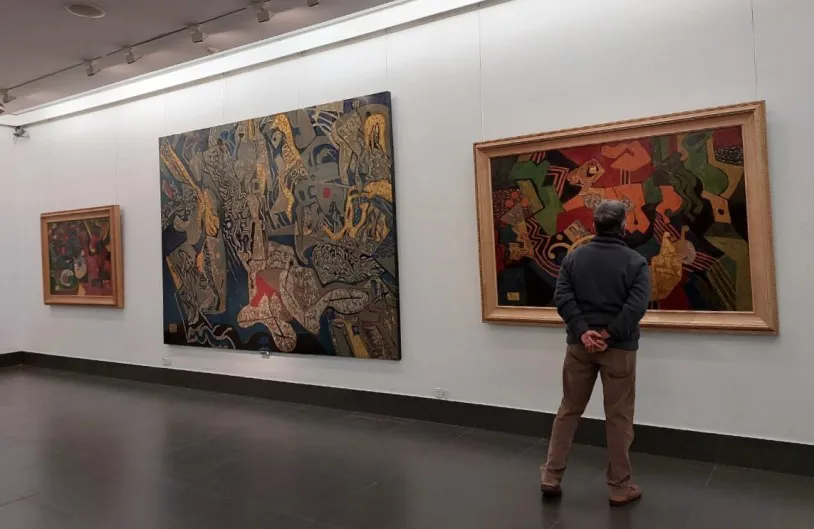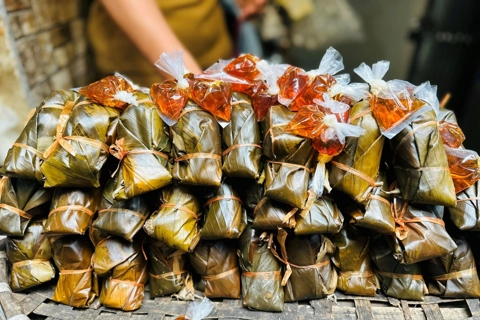Sculptor and painter Ta Quang Bao: An icon of Vietnamese art
Hanoi-based sculptor Ta Quang Bao is considered an exceptional artist in Vietnamese visual arts, having created many monuments throughout the country.
For half a century, Hanoi-based sculptor Ta Quang Bao has made a career out of stone, iron, steel, and cement.
His Ho Keo Phao (Singing when Pulling Cannon) monument in the northern province of Dien Bien set a national record when it was completed in 2009, standing 11 meters tall and made from 100 blocks of green stone weighing 1,200 tons. He is also the author of other imposing monuments in Buon Me Thuot City, Vinh Phuc Province, and Hai Van Pass.
Sculpting his career
Born in 1941, sculptor Ta Quang Bao studied at the Intermediate School of Industrial Fine Arts in Hanoi (later renamed the College of Industrial Fine Arts and now the Hanoi University of Industrial Fine Arts) from 1959 to 1963. After graduating, he worked at the newly established Vietnam Fine Arts Museum. In 1966, he continued his studies at the Sculpture Faculty of the College of Industrial Fine Arts. He enlisted in the army and was sent to the battlefield in central Vietnam, where he joined the military art troupe of Region V.
The monument "Singing While Pulling the Cannon" created by Ta Quang Bao in the northern province of Dien Bien. Photo: Internet |
He both fought in battle and used the rare time between battles to create.
With hundreds of works in his family museum, dozens of statues in national museums, and dozens of monuments across the country, he has become a leading figure in Vietnamese sculpture. The recurring theme in his work is the revolutionary war, with images of resilient Vietnamese mothers and heroic soldiers who dedicated their lives to the Fatherland.
"For me, making statues is life and joy. I believe that man must live with ideals, ambitions, and dreams. To do this, people must work, create, and leave behind the lasting values of honest labor," he said.
Painting gives old sculptor new life
When he was in his 80s, sculptor Ta Quang Bao decided to embark on a new artistic adventure - lacquer painting. After three years of lacquer painting, he amazed his fellow artists and the public with 50 large-scale lacquer works in the exhibition Ta Quang Bao's Paintings, which opened in Hanoi in late December 2023.
Through his works, Bao expressed his 50 moods about people, life, and nature with a rich and new color palette.
Artist Ta Quang Bao (C) and artist Ngo Xuan Binh (R) at Ta Quang Bao's recent exhibition. Photo: Ngo Minh/The Hanoi Times |
Speaking about the exhibition, he briefly said: "As long as I'm alive, I will continue to make art, and to make art is to discover."
When asked why lacquer painting, he replied: "Because it is a unique painting material of the nation, it can make a worthy contribution to world fine arts."
Researcher Nguyen The Khoa affirmed that Bao is the person who has made Vietnamese sculpture the national pride in his 60 years of creation, and in the past three years of lacquer painting, he has also made Vietnamese fine arts the national pride.
"It was as if a hurricane swept Ta Quang Bao into lacquer and dipped him in it to bring us a new creative world. He uses only Vietnamese lacquer, not Chinese or Japanese, so his lacquer paintings are truly Vietnamese," Khoa said.
| Ta Quang Bao's first lacquer painting exhibition as a painter. Photo: Ngo Minh/The Hanoi Times |
Artist Ngo Xuan Binh added that Bao was an exceptional artist in Vietnam because at his age he could create large lacquer paintings. Traditional lacquer has limitations in colors and in expressing multi-dimensional space, which was no problem for his paintings.
"With this exhibition, Bao has not only created a trend, style, and greatness for the prolific collection of lacquer paintings, but he has also emphasized the identity of Ta Quang Bao. My visits to his house are usually fleeting, but enough to perceive that his sculptures and paintings are great, impressive, and imposing," Binh said.
According to artist Luong Xuan Doan, Chairman of the Vietnam Fine Arts Association, Bao is an artist who grew up in the resistance war. His career is closely linked to the development of modern Vietnamese fine arts. He is one of the few Vietnamese artists to have won two of the country's highest awards: The Ho Chi Minh Prize for Art and Literature and the State Prize for Art and Literature. Generations of artists will remember and be grateful for his contributions as a master, an icon of modern fine arts.














